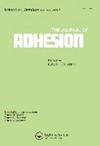基于试验设计的复合材料粘结接头II型参数化研究
IF 2.3
4区 材料科学
Q2 ENGINEERING, CHEMICAL
引用次数: 0
摘要
在有限的资源和日益增长的环境问题下,追求可持续发展的未来,粘合剂连接作为轻量化结构进步的关键技术脱颖而出。采用基于实验设计(DoE)方法的新方法,研究了不同变量对缺口端弯曲(ENF)键合复合材料接头II型临界应变能释放率(GIIc)的影响。ENF粘结复合材料接头的二维有限元模型是使用商业软件开发的,所有数值模型都是通过与Abaqus链接的Python™脚本生成的Ⓡ。系统地评估了与试样几何形状和材料特性相关的11个设计参数,以确定每个变量对GIIc的影响。得到了数值力-位移曲线,应用基于柔度的梁法(CBBM)估计了II型的临界断裂能,用数值包络线表示。使用主效应(ME)度量来评估每个参数的影响。对GIIc和CBBM影响最大的前5个变量分别是黏着剂II型临界应变能释放率(GIIc)、有效层压纵向弹性模量(E - h)、黏着剂厚度(tA)、黏着剂厚度(h)和预裂长度(a0)。此外,该研究强调了与几何变量相关的认知不确定性。尽管计算模型存在固有的局限性,但Plackett-Burman方法在进行ENF测试中变量的敏感性分析方面一直被证明是有效的。这些结果为该方法在复合材料接头结构设计中的应用提供了良好的前景。本文章由计算机程序翻译,如有差异,请以英文原文为准。
Parametric investigation of bonded composite joints under Mode II using a new methodology based on design of experiments
In the pursuit of a sustainable future with limited resources and growing environmental concerns, adhesive joining stands out as a pivotal technology for the advancement of lightweight structures. This study aims to investigate the influence of various variables on the critical strain energy release rate in mode II (GIIc) for End-Notched Flexure (ENF) bonded composite joints, employing a new methodology based on Design of Experiments (DoE) approach. Two-dimensional finite element models of the ENF bonded composite joints are developed using commercial software, with all numerical models generated via Python™ scripts linked with AbaqusⓇ. Eleven design parameters related to the specimen geometry and material properties are systematically evaluated to determine the influence of each variable on GIIc. Numerical force–displacement curves are obtained, followed by the application of the Compliance-Based Beam Method (CBBM) to estimate the critical fracture energy in mode II, represented by a numerical envelope. The influence of each parameter is assessed using the main effect (ME) metric. The top five most influential variables affecting GIIc and CBBM are identified as the adhesive’s critical strain energy release rate in mode II (GIIc), effective laminate longitudinal elastic modulus (Eˉyy), adhesive thickness (tA), adherent thickness (h), and pre-crack length (a0). Furthermore, the study highlights the epistemic uncertainty associated with the geometric variables. Despite the limitations inherent in the computational model, the Plackett-Burman method consistently proves effective in conducting sensitivity analysis of the variables in the ENF test. These findings demonstrate promising prospects for the application of this procedure in the design of composite joint structures.
求助全文
通过发布文献求助,成功后即可免费获取论文全文。
去求助
来源期刊

Journal of Adhesion
工程技术-材料科学:综合
CiteScore
5.30
自引率
9.10%
发文量
55
审稿时长
1 months
期刊介绍:
The Journal of Adhesion is dedicated to perpetuating understanding of the phenomenon of adhesion and its practical applications. The art of adhesion is maturing into a science that requires a broad, coordinated interdisciplinary effort to help illuminate its complex nature and numerous manifestations.
 求助内容:
求助内容: 应助结果提醒方式:
应助结果提醒方式:


